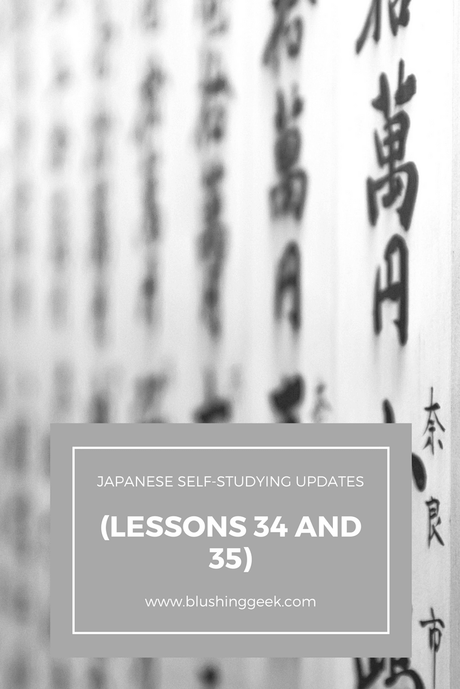Konnichiwa minna-san!
It’s Monday once again so it’s time for my Japanese self-study updates! I’ve been doing this written weekly updates since September and I’m sure a few of you we’re already sick of it, haha (no hard feelings, *wink). Honestly? I am too. I am thinking of doing a video update so you guys can see that I am really learning and not just bluffing, haha. But I’m not yet ready for such, so please bear a little, haha.
So as a summary, what I studied last week was on how to say have to do something / must do something / gotta do something in Japanese. The other lesson was a review test of all the verbs I’ve learned since lesson 1, and my! It was pretty long, yet rewarding since I’m familiar with them now. Yey! And this week, I’m going to learn two more.
And again, this is not an attempt to create a tutorial but just sharing what I’ve learn from Misa-sensei’s Grammar Lessons for Absolute Beginners in Youtube. You can see what I’ve been learning from Lessons 1-33 here.
Click on the lesson number to read the whole update.LESSON #34: Go To Do *Purpose* / In Order To
<verb (plain)> + tame ni
= … (in order) to ~Ex: I exercise everyday (in order) to lose weight
=> Yaseru tame ni mainichi undou suru / shimasu
I’ve been exercising every (in order) to lose weight
=> Yaseru tame ni mainichi undou shiteiru / shiteimasu
I bought a Kindle (in order) to read books
=> Hon wo yomu tame ni, kindoru wo katta / kaimashita
Review from Lesson #33
<noun> + NO tame ni
= I do … for <noun>
Ex: I made a cake for my boyfriend on Valentine’s Day
=> Barentaindee ni kare no tame ni keeki wo tsukutta / tsukurimashita
For “I’ll go (in order) to do ~”, you could say:
=> ~ tame ni (to where) ni iku
But they have a special way to do it. Instead, they say:
=> ~ ni iku
Ex: I will go to the library to borrow a book
=> Toshokan ni hon wo kari ni iku / ikimasu
To put a verb in front of ni iku, you use a half masu form. Ex: kariru => karimasu => kari
iru/eru ending verbs:
- change masu into ni iku
other ending verbs:
- change u into i and then add ni iku
Ex: to go borrow
=> kari ni iku / ikimasu
You can always conjugate the last verb, which is iku into any form. Like for example:
<verb> ni ikitai
= WANT to go to <verb>
Ex: I want to go to the library to borrow a book
=> Toshokan ni hon wo kari ni ikitai (desu)
Or say:
<verb> ni ikanakya
= HAVE to go to <verb>
Ex: I have to go to the library to borrow a book
=> Toshokan ni hon wo kari ni ikanakya <informal>
~ wo kaesu
= to return ~
(~ wo) kaesu VS. (wa) kaeru
to return (something) VS. (I) return / goes home
I will go to the library to return a book
=> Toshokan ni hon wo kaeshi ni iku / ikimasu
I have to go to the library to return a book
=> Toshokan ni hon wo kaeshi ni ikanakya <informal>
I will go to the restaurant to eat dinner
=> Resutoran ni bangohan wo tabe ni iku / ikimasu
I will go to the restaurant to eat dinner with my friend
=> Resutoran ni tomodachi to bangohan wo tabe ni iku / ikimasu
izakaya => a japanese-style pub
I am going to an izakaya to drink
=> Izakaya ni nomi ni iku / ikimasu
<noun> no ato
= after <noun>
I’m going to an izakaya after work
=> Shigoto no ato, izakaya ni nomi iku / ikimasu
I’m going to Japan to study Japanese
=> Nihon ni nihongo wo benkyou shi ni iku / ikimasu
I want to go to Japan to study Japanese
=> Nihon ni nihongo wo benkyou shi ni ikitai (desu)
rushia => Russia
baree => ballet
I want to go to Russia to see a ballet
=> Rushia ni baree wo mi ni ikitai (desu)
I will go to Japan to climb Mt. Fuji
=> Nihon ni fuji san ni nobori ni iku / ikimasu
I want to go to Japan to climb Mt. Fuji
=> Nihon ni fuji san ni nobori ni ikitai (desu)
I went to Japan to see my friend
=> Nihon ni tomodachi ni ai ni itta / ikimashita
For the example above, we use the verb au (to meet) instead of miru (to look, to see, to watch). Why?
friend wo miru
= to LOOK at a friend
It doesn’t sound right, aight? That’s why we use the verb au (to meet) instead. But you could also use the ~ tame ni (to where) ni iku:
=> Tomodachi ni au tame ni, nihon ni itta / ikimashita
(this is less common)
Spiderman went to save his girlfriend
=> Supaidaaman wa kanojo wo tasuke ni itta / ikimashita
~ wo tasukeru
= to save (someone)
otouto => little brother
to help my little brother with his homework
=> Otouto no shukudai wo tetsudau / tetsudaimasu
~ wo tasukeru VS. ~ wo tetsudau
to save (someone) VS. to help someone with something
Went to see a movie
=> Eiga wo mi ni itta / ikimashita
Went to a shopping mall to buy clothes
=> Shoppingu mooru ni fuku wo kai ni itta / ikimashita
New vocabularies learned from this lesson:
- kaesu => to return (something)
- izakaya => a japanese-style pub
- <noun> no ato => after <noun>
- rushia => Russia
- baree => ballet
- otouto => little brother
LESSON #35: LET’S in Japanese
Let’s (formal)
- change masu into mashou
Ex: Let’s eat
=> Tabemashou
Let’s eat dinner
=> Bangohan wo tabemashou
Let’s eat dinner together
=> Isshoni bangohan wo tabemashou
Let’s go eat dinner
=> Bangohan wo tabe ni ikimashou
Let’s go to the restaurant to eat dinner
=> Resutoran ni bangohan wo tabe ni ikimashou
Let’s see movie together
=> Isshoni eiga wo mimashou
sou desu ne
= I agree / let’s see <thinking>
Let’s go to the cinema and see a movie
=> Eiga kan ni eiga wo mi ni ikimashou
Let’s study Japanese
=> Nihongo wo benkyou shimashou
Let’s study at the library
=> Toshokan de benkyou shimashou
For “please be quiet”, you can say it using the TE form, but in Japan, they often say “let’s be quiet”, especially in a place where you are expected to follow the rules.
shizuka ni suru => to be quiet
Please be quiet
=> Shizuka ni shite (kudasai)
Let’s be quiet
=> Shizuka ni shimashou
In Japan’s public place, you will usually see this mashou form rather than then the te kudasai. So instead of:
Kirei ni tsukatte kudasai
= Please use it cleanly / Please keep it clean
they use:
Kirei ni tsukimashou
= Let’s use it cleanly (neatly) / Keep it clean
Let’s speak Japanese
=> Nihongo wo hanashimashou
Let’s talk in Japanese
=> Nihongo de hanashimashou
Let’s (informal)
- iru / eru ending = change ru into you
- pronounced as a long o sound
Ex: King
=> Oosama
(pronounced as: OOsama)
Let’s eat
=> Tabeyou
Unlike English, in Japanese, they add in/at (de/ni) with here (koko)
Let’s eat here
=> Koko de tabeyou
Let’s eat lunch here
=> Koko de hirugohan wo tabeyou
Let’s open the presents
=> Purezento wo akeyou
Let’s sleep soon
=> Mousugu neyou
The verb deru which can mean a lot of things, but the most common is to leave. It can only mean something like: to leave the building etc. But if you have a purpose, like you go out to have fun, you use the verb dekakeru.
dekakeru => to go out (usually to have fun)
Let’s go out
=> Dekakeyou
Irregular verbs also have this you ending
- suru => shiyou
- kuru => koyou
Let’s study together
=> Isshoni benkyou shiyou
Let’s study at the library
=> Toshokan de benkyou shiyou
Let’s play tennis
=> Tenisu shiyou
renshuu suru => to practice
Let’s practice
=> Renshuu shiyou
mata => again
Kuru (to come) always requires ni particle.Let’s come here again
=> Koko ni koyou
Let’s bring photos
=> Shashin wo motte koyou
Other verbs
- change u into o and add u
Ex: Let’s go
=> Ikou
Let’s go to Japan
=> Nihon ni ikou
Let’s go to Kyoto
=> Kyoutou ni ikou
Let’s go to the restaurant to eat
=> Resutoran ni tabe ni ikou
Let’s go drink after work
=> Shigoto no ato, nomi ni ikou
Let’s drink tea
=> Ocha wo nomou
Let’s hangout
=> Asobou
Let’s hangout again
=> Mata asobou (ne)
Let’s meet
=> Aou
ao => blue
Let’s buy
=> Kaou
kao => face
Let’s buy a new car
=> Atarashii kuruma wo kaou
Let’s buy a house
=> Ie wo kaou
Let’s take a picture
=> Shashin wo torou
Let’s take a picture together
=> Isshoni shashin wo torou
dansu suru / oduru => to dance
Let’s dance together
=> Isshoni odorou
Let’s do our best
=> Ganbarou
Let’s wait
=> Matou
Let’s wait for Matt
=> Matto wo matou
Let’s win
=> Katou
someone ni katsu
~ ni katsu
= to beat / defeat / take ~ out
(in a sense of “win or lose”)
By the way, Kato is a very common surname in Japan
Let’s beat Kato
=> Katou ni katou
New vocabularies learned from this lesson:
- shizuka ni suru => to be quiet
- dekakeru => to go out (usually to have fun)
- renshuu suru => to practice
- mata => again
- ao => blue
- kao => face
- dansu suru / oduru => to dance
- matto => Matt
That’s it for this welek. Can’t wait to see what I’m going to learn next week, *wink.
For the earlier lessons, you can refer to my previous updates for lessons 1-33. And again, if you want to study Japanese language as well, I am highly recommending Misa-sensei’s youtube tutorial for Japanese Grammar Lessons for Absolute Beginners. Jaa mata ne!


